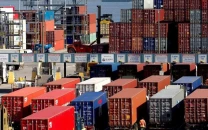Guide to ending the power crisis
Solution lies in liberalisation to create a wholesale electricity market

Excessive presence of the government in the power sector is encouraging malpractices. PHOTO: FILE
Let’s trace the history of the crisis that continues to plague the power sector. During mid-to-late 2000s, the cost of producing electricity had been continuously increasing due to an increase in international oil prices, a depreciating rupee and rising overall inflation in the country. This forced DISCOs, which buy electricity from power producers, to request the National Electric Power Regulatory Authority (Nepra) to revise the electricity tariffs upwards.
Power outages planned to be cut by half from Nov
The government, however, resisted these demands by keeping the tariffs fixed on the pretext of consumer welfare. This meant that DISCOs were purchasing electricity from the IPPs and other GENCOs at a higher price than they were supplying electricity at.
In particular, during the crunch of 2007-08, when Pakistan was going into the election cycle, and the then government was under siege from a movement for the restoration of Justice Iftikhar Chaudhry, the government did not pass on these ballooning costs to consumers. That set the genie of circular debt on the loose.
The differential between the reported cost of distributing electricity and end-user uniform tariffs, as notified by the Ministry of Water and Power, was to be compensated by a subsidy called tariff differential subsidy (TDS). However, it should be stressed that the costs claimed by DISCOs may not be justified in all cases, especially when one takes into consideration the high degree of transmission and distribution losses factored into the cost.
The budgeted amount of these subsidies by the government was always far less than those actually claimed by DISCOs. Resultantly, DISCOs experienced deficit in payments that they owed to the IPPs, which were being run on thermal oil.
As the IPPs also failed to make payments to the suppliers of oil, this turned the whole system cash-strapped. This liquidity crunch in the power sector reduced the actual generation of electricity as the IPPs were forced to cut down their production levels.
To make matters worse, the government extended subsidies to other arenas that had little effect (or arguable adverse effect) on the general welfare. The government was subsidising the IPPs for producing oil-based electricity rather than gas, which was a cheaper option. The underlying reason was to encourage consumption of CNG in the country.
Households waste 25% of electricity in Pakistan: study
There is another subsidy called tube-well subsidy that federal and provincial governments pay for the welfare of tube-well users, especially in Balochistan. In addition to this, both federal and provincial governments default frequently on payment of electricity bills. It is the accumulation of these liabilities that contributed to the circular debt, which now stands at around Rs300 billion.
Protection for a short while
While subsidies did protect the consumers for a short while, almost a decade-long load-shedding that ensued, largely due to it, reversed these welfare gains more than proportionately. According to one estimate, textile exports worth $5 billion were lost due to energy crisis.
It has translated into a loss of millions of dollars in both domestic and foreign investments and scores of individuals have lost their jobs.
A long-term solution to ensure that the circular debt does not re-surface is to decrease the footprints of government in the power sector. Its excessive presence in the sector is encouraging malpractices.
For example, being state-owned enterprises (SOEs), DISCOs are marred with political overstaffing which has inflated payrolls to high levels. Since the government continues to bail out such SOEs, there is little incentive to economise on costs and be more productive. Consequently, the system losses for DISCOs have been higher than those allowed by Nepra.
Competitive environment
It is becoming increasingly apparent that the PML-N’s privatisation programme for DISCOs has gone adrift. In an independent scorecard, the DISCOs privatisation programme received only 5 out of 10. However, pumping money into the power sector is not a sustainable solution.
In line with its manifesto, the PML-N should proceed with its privatisation programme of DISCOs. However, prior to privatisation, an environment leading to competition and liberalisation ought to be created.
A DISCO having monopoly in a huge city with a private ownership without any competition will not be necessarily better than a government-owned DISCO. There is a text book solution: establish a wholesale energy market and move away from a single buyer to a multiple buyer market.
The writers are associated with PRIME Institute, an independent think tank based in Islamabad
Published in The Express Tribune, November 21st, 2016.
Like Business on Facebook, follow @TribuneBiz on Twitter to stay informed and join in the conversation.



















COMMENTS
Comments are moderated and generally will be posted if they are on-topic and not abusive.
For more information, please see our Comments FAQ